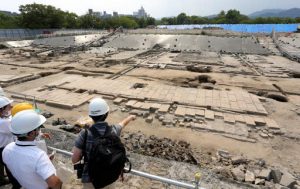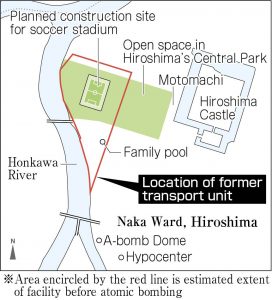Striving to fill voids in Hiroshima—Unearthed remnants of “military city” revealed to media at Hiroshima’s site of new soccer stadium
Jun. 26, 2021
by Kyosuke Mizukawa, Staff Writer
On June 25, the Hiroshima City government opened up to the media the recently excavated remnants of the former Japanese Army’s transport unit known as the Chugoku District transport soldier recruitment unit (“Shichotai” in Japanese). The artifacts were discovered in the inner space of Central Park, the planned site of a new soccer stadium, located in Hiroshima’s Naka Ward. The remnants are one of the largest A-bombed facilities ever excavated in the city area of Hiroshima. The unearthed structures include horse stables and barracks destroyed in the U.S. military’s atomic bombing of Hiroshima.
About 6,000 square meters now being surveyed of a total of 14,000 square meters were made available to the media. Most of the Shichotai ruins were found at a depth of slightly more than one meter underground. Some parts of the space were excavated down to layers dating around the time of the Edo era in Japan (1603–1868).
A staff member of the Hiroshima City Culture Foundation, the organization conducting the excavation work commissioned by the city, explained details about the unearthed facilities, which include foundations of stone or asphalt for four stables for the rearing of war-horses used to carry military supplies in battle zones, the ruins of military barracks, and watering areas for the horses. The group has also discovered horseshoes, the bones of horses, and bullets used by soldiers in the former army unit.
The city’s Cultural Promotion Division said, “These artifacts of the military facilities are in unexpectedly good condition. They can be used to convey the sense that Hiroshima was a military city before the war.” The city will consider cutting out a portion of the land for preservation at a separate location before removal work starts in July.
The city initiated the excavation efforts last year to maintain a record of the facility artifacts before they are lost to construction of the soccer stadium. The investigation will continue until March of next year. The city announced its plans to hold a briefing session using photographs at a city facility in late July, in place of providing an on-site briefing for citizens.
Keywords
Chugoku District transport soldier recruitment unit
The Chugoku District transport soldier recruitment unit was assigned to transport arms, ammunition, and food using horses and motor vehicles. Soldiers were trained on site and dispatched to various war fronts. Starting as the fifth platoon of transport soldiers on the west side of Hiroshima Castle in 1880, the unit grew larger and changed names over time. According to the Hiroshima Shicho Heitai Shi (History of Hiroshima Transport Soldiers, in English), published in 1973, 423 people in the unit were killed or designated as missing and 343 people were injured in the atomic bombing.
(Originally published on June 26, 2021)
On June 25, the Hiroshima City government opened up to the media the recently excavated remnants of the former Japanese Army’s transport unit known as the Chugoku District transport soldier recruitment unit (“Shichotai” in Japanese). The artifacts were discovered in the inner space of Central Park, the planned site of a new soccer stadium, located in Hiroshima’s Naka Ward. The remnants are one of the largest A-bombed facilities ever excavated in the city area of Hiroshima. The unearthed structures include horse stables and barracks destroyed in the U.S. military’s atomic bombing of Hiroshima.
About 6,000 square meters now being surveyed of a total of 14,000 square meters were made available to the media. Most of the Shichotai ruins were found at a depth of slightly more than one meter underground. Some parts of the space were excavated down to layers dating around the time of the Edo era in Japan (1603–1868).
A staff member of the Hiroshima City Culture Foundation, the organization conducting the excavation work commissioned by the city, explained details about the unearthed facilities, which include foundations of stone or asphalt for four stables for the rearing of war-horses used to carry military supplies in battle zones, the ruins of military barracks, and watering areas for the horses. The group has also discovered horseshoes, the bones of horses, and bullets used by soldiers in the former army unit.
The city’s Cultural Promotion Division said, “These artifacts of the military facilities are in unexpectedly good condition. They can be used to convey the sense that Hiroshima was a military city before the war.” The city will consider cutting out a portion of the land for preservation at a separate location before removal work starts in July.
The city initiated the excavation efforts last year to maintain a record of the facility artifacts before they are lost to construction of the soccer stadium. The investigation will continue until March of next year. The city announced its plans to hold a briefing session using photographs at a city facility in late July, in place of providing an on-site briefing for citizens.
Keywords
Chugoku District transport soldier recruitment unit
The Chugoku District transport soldier recruitment unit was assigned to transport arms, ammunition, and food using horses and motor vehicles. Soldiers were trained on site and dispatched to various war fronts. Starting as the fifth platoon of transport soldiers on the west side of Hiroshima Castle in 1880, the unit grew larger and changed names over time. According to the Hiroshima Shicho Heitai Shi (History of Hiroshima Transport Soldiers, in English), published in 1973, 423 people in the unit were killed or designated as missing and 343 people were injured in the atomic bombing.
(Originally published on June 26, 2021)









